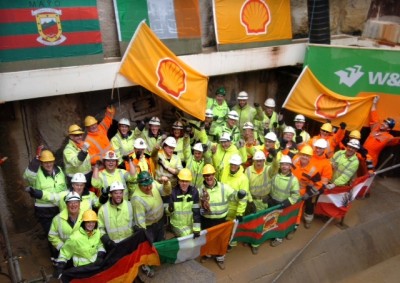The longest tunnel ever built in Ireland has just been completed in Co. Mayo. The 4.9 km tunnel, (which is 300 m longer than Dublin’s Port Tunnel) has been under construction since January 2013.
The tunnel runs under Sruwaddacon Bay, a special area of conservation (SAC), and will house a key onshore section of the Corrib gas pipeline.
[rev_slider Surety]
The tunnel will be used to connect the previously laid 83 km offshore pipeline from the Corrib Field to the Bellanaboy Bridge Gas Processing Terminal.
Excavation of the Corrib tunnel started in January 2013 using a German designed tunnel boring machine (TBM) called ‘Fionnuala’. The 140 metre long TBM and its crew have been working around the clock drilling through rock, sand and clay at depths of between 5.5 m and 12 m under Sruwaddacon Bay.
Construction of the tunnel was undertaken by a joint venture between BAM Civil and Wayss & Freytag Ingenieurbau, both operating companies of Royal BAM Group. As the TBM advanced, over 25,000 concrete ring segments, which were pre-fabricated in Ireland were installed to line the tunnel.
Speaking after the TBM had broken through the final metres of rock at the Glengad landfall site in North Mayo, Michael Crothers, Managing Director of Shell E&P Ireland, said: ‘On behalf of the Corrib partners Shell, Statoil and Vermilion, we congratulate the entire team on a remarkable achievement. The completion of the Corrib tunnel brings us a step closer to producing First Gas in 2015 and to improving security of supply for the Irish energy market.’
Reflecting on this important milestone, Corrib Project Director, Roeland Borsboom, commented: ‘The innovative work that has been undertaken in successfully building the tunnel in an SAC is a remarkable example of engineering excellence. Our tunnelling team has, at every stage, adopted measures to minimise risks, as well as construction and environmental impacts on the local community.’
Good progress continues to be made on other significant elements of the Corrib project. Approximately 1,000 construction workers are currently employed putting the finishing touches to the project in Mayo, Donegal, Dublin and offshore at the Corrib field. ‘An extensive schedule of offshore work has begun with the arrival of the ‘Ocean Guardian’ drilling rig at the Corrib field to prepare and test wells ahead of first gas production’, said Mr Borsboom.
At the same time, the Bellanaboy Bridge Gas Terminal, which is 98% complete, is preparing to use ‘backfeed’ gas from the national grid to test the newly constructed terminal facilities in the autumn.
In the coming weeks, work will commence inside the completed tunnel, on the welding and installation of the 20-inch diameter gas pipeline, control umbilical and related services. Testing of the pipeline will then take place before the tunnel is backfilled with a grout mix to completely seal it. The finished pipeline will then be ready to transport gas from the Corrib field to the Bellanaboy Bridge Gas Terminal for processing.
The Corrib Gas Tunnel in numbers:
- 500 tonnes: the weight of the TBM
- 140 metres: the length of the TBM
- 28 tonnes: the weight of the TBM cutter head
- 15 tonnes: the amount of food and water consumed weekly by the tunnelling team
- 4.9 km’s: the length of the tunnel
The Corrib Gas Partners are Shell E&P Ireland Limited (45% and operators), Statoil Exploration Ireland Limited (36.5%) and Vermilion Energy Ireland Limited (18.5%).
The Corrib gas field contains an estimated 1 trillion cubic feet of gas.
At peak production, Corrib has the potential to meet up to 60% of Ireland’s gas needs.
A 20 page booklet telling the story of the building of the Corrib Gas Tunnel can be viewed at: www.shell.ie/aboutshell/our-business-tpkg/e-and-p/corrib/corrib-tunnel/tunnelling-update-may-2014.html




